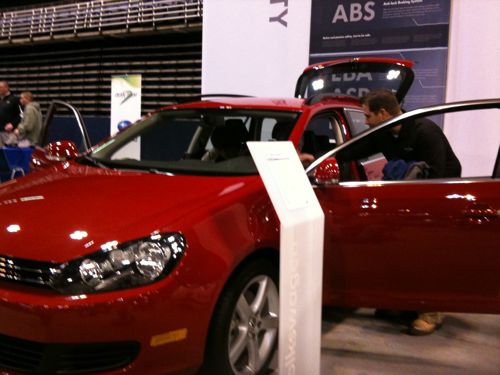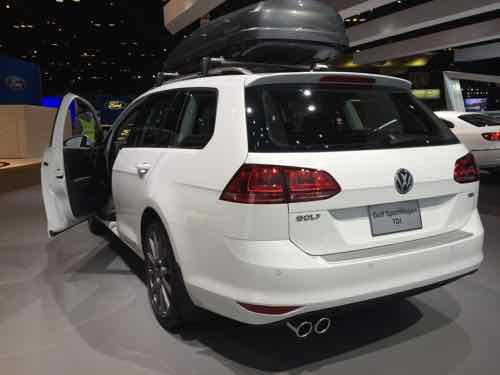The Volkswagen Group Wanted To Be The World’s Biggest Carmaker, Cheated In Attempting To Reach Goal
I’m fascinated by Volkswagen’s emissions-rigging scheme — writing software to make diesel cars perform differently while being tested vs. driven. Why would they do this?
To make sense of it we need to go back to 2007 for the planned introduction of new Volkswagen TDI engine for the 2008 model year:
Amid the looming hordes of European luxury automakers planning a North American compression-ignition invasion in the next couple years, humble Volkswagen has announced its plans to return the Jetta TDI to the diesel dogpile in the spring of 2008. Powered by a new 2.0-liter four-cylinder making 140 hp and 236 lb-ft of torque, and either a six-speed manual or DSG automated manual transmission, the 2008 Jetta TDI will be cleared for sale in all fifty states.
Some of the earlier diesels to make it to our shores over the next few years will only be available in 45 states; California, Maine, Massachusetts, New York, and Vermont have all adopted stricter emissions regulations for diesels that bar some vehicles from entry. Using technology developed under the BlueTec cooperative formed by Mercedes-Benz and Volkswagen, the Jetta TDI will slip by these stricter regulations without resorting to a urea-based exhaust treatment, as many BlueTec labeled models will.
Nitrogen oxides (NOx) are, along with particulate emissions (soot), the biggest hurdles facing diesels in the U.S. Most BlueTec vehicles will control NOx by injecting a urea-based solution called AdBlue into the exhaust system upstream of a catalytic converter that specifically targets NOx. In that catalytic converter, the ammonia in the urea reacts with the NOx in the exhaust gas and neutralizes it into nitrogen and water.
Volkswagen’s Jetta TDI will manage without a urea injection system by using a NOx-storage catalyst. Like the particulate filters in place on this car as well as other diesels, this catalyst is basically a trap that temporarily holds the offensive emissions. Periodically, the engine will switch to an air-fuel mixture that will burn off the material in the traps.
Delayed a year, this new 2.0 TDI didn’t debut until the 2009 model year. The previous 1.9 TDI engine was sluggish and didn’t meet newer emissions standards — Volkswagen had no 4-cylindar diesel engine for U.S. models during the 2007 & 2008 model years.
From 2005 to 2006, the Jetta TDI is powered by a 1.9-liter four-cylinder turbodiesel engine (TDI stands for Turbo Direct Injection) good for 100 horsepower, but a healthy 177 pounds-feet of torque. Remember, torque is a rotational force required to get a car moving, so the more torque an engine has, the quicker it can move a car either from a standing stop or when overtaking slower traffic. 2009 and newer Jettas feature an all-new 2.0-liter four-cylinder turbocharged engine with VW’s “clean diesel” technology. The clean diesel features particulate filters and other devices for removing diesel soot and order from the exhaust, as well as a system for reducing emissions. The 2.0-liter TDI produces 140 horsepower and whopping 236 pounds-feet of torque. While the 1.9-liter engine can best be described as peppy, the 2.0-liter TDI is down right quick. Rocketing out of a tollbooth or merging onto the freeway is a snap for the 2.0-liter TDI, which feels more like the GTI’s 200-horsepower turbocharged gas engine than a powerplant designed for maximum mileage. (AutoTrader August 2011)
The new 2.0 TDI engine was able to meet stricter worldwide emissions standards without using an urea injection to clean the exhaust — brilliant engineering, or so we thought. Every other diesel required urea injection, which had to be refilled about every 10,000 miles. When Mercedes BlueTEC diesels run out of urea you can start it only 20 more times before refilling it (TheCarConnection).
Over the years since the new 2.0 TDI engine was introduced the automotive press raved about it, and consumers bought more and more. After all, the performance was outstanding and the real world MPG exceeded EPA estimates. As we’ve learned, their urea injection-free diesel didn’t meet emissions standards. Their “CleanDiesel” wasn’t clean at all.

Sales of their diesels broke records:
VW Group of America has had great success with diesels in the US recently. Vee-Dub and Audi sold 105,899 diesel-equipped models in 2013. It was the first time the group ever sold over 100,000 diesels in a year, and they accounted for 24 percent of sales. (AutoBlog)
At the Chicago Auto Show in February we saw the newest SportWagen TDI — now a Golf — with a new TDI engine.

Volkswagen had a stated goal of becoming the biggest car maker in the world, and for the first six months of 2015 they were:
Volkswagen (VLKAF) sold 5.04 million vehicles from January to June, a slight dip from a year earlier. That compares to 5.02 million sold by Toyota (TM) over the same period. Group sales dropped 1.5% due to a weaker performance by its Toyota and Daihatsu brands. (CNN/Money)
Many were expecting a close race between Toyota and the Volkswagen Group for top honors for 2015, now Toyota will locket retain the crown as Volkswagen deals with the fallout. My friends who own these polluting diesels are furious they were deceived. I’m furious millions of these cars have been polluting the environment while billed as eco-friendly clean cars.
— Steve Patterson
Everyone “cheats”, aka designs their vehicles to “pass” the established (and arbitrary) “rules” and tests, as in “your mileage will vary”. VW just pushed too far and got caught. The real bottom line is that all vehicles and the air we breathe is far cleaner, today, than it was 50 years ago. We have a far bigger problem, here in the midwest, from good ole boys “rolling coal”, polluting far, far worse than any VW does any day of the week: https://www.youtube.com/watch?v=JGYc0wCP7oQ
No, other companies haven’t defrauded government regulators all over the world. Other car makers subject their cars to testing.
http://jalopnik.com/watchdog-group-says-other-car-companies-are-cheating-on-1732615322
Interesting. Diesels are a bigger deal in Europe than here. Could explain why other companies didn’t blow the whistle on VW.
For repeatability, the government emissions tests are highly structured, going through a prescribed series of steps in a controlled environment. It’s much like “teaching to the test” in public schools – if the desired outcome is students that do well on the test, you teach them to pass the test(s); if you want them to do well in life, you teach critical thinking and problem solving. No, they’re not mutually exclusive, but they ARE different.
With computerized controls on both engines and transmissions, relying on multiple sensors, it’s not surprising that small tweaks can make big differences. The real issue, with VW, is that they were too blatant, with too big a difference in their settings. Everyone in the business is trying to balance low emissions and high performance, and everyone is trying to sell what they make (and performance sells).
I’m amazed that the competitions’ engineering divisions ( of Toyota, Mazda, GM, etc.) didn’t first discover the fraud by purchasing then dissecting one of the TDI diesel engines , in an effort to understand VW’s new technology, then to figure out how to apply that technology to their own lineups. The software employed in the execution of this scam is brilliant! I wish VW would apply some of that brilliance to the design and (especially) the quality control of their products.
Exactly, Mercedes was a partner in developing BlueTEC diesel technology. It’s also possible the other companies attempted this but couldn’t figure out how the vehicles passed EU & American emissions testing. They may have tested a car and found it passed — not knowing the software was designed to cheat.
You’re right. The competition probably first tested the composite design to confirm VW and the Gov’t’s findings. But later, I can’t imagine that one or several of their competitions’ mechanical engineers didn’t thoroughly “anatomize” the engine to learn exactly why it performed per the composite test results. In the end, it looks as if VW pulled a really fast one on their customer base and on their competition, and it looks as if the competitions’ engineering divisions might have unknowingly played a part in the hoax.
It’s conveniently illegal in the United States for anyone, including the government, to examine the contents of an automobile’s computer system. I’d say we were giving them a pretty strong incentive to cheat.
I know nothing about automobile design or construction. When I suggested that the mechanical engineers dissect the engines, I wasn’t necessarily suggesting examining the computer system, largely because I don’t know if an engine’s performance/EPA compliance is a function of the engine design (mechanical) or of the computer system, or a combination of the two. It seems to me that a qualified mechanical engineer and/or an experienced auto mechanic could first investigate the mechanics of the engine, and then if nothing showed up that would necessarily account for performance/EPA compliance levels per VW’s results, ……then the next logical step would be to call for an investigation of the role of the computer system. (I’m certain every manufacturer knows that the computer system can be illegally “tweeked” to achieve desired results–so after thorough investigation of the (mechanical) engine design, they should have been quick to determine that some funny business was going on with the computer.)
The computer was the key in passing the emissions test, not the engine design. The computer was able to recognize the car was being tested, which then told the engine to lower emissions to the legal limit. After the test, it recognized that too and ramped the emissions way above the legal limit. How exactly they figured out what was going on is not clear to me, but it took 7 years, and undoubtedly required very indirect methods. If the EPA used the computer was a point of reference, they would be sued and the evidence would be inadmissible in court. My point is that if the computer system was simply legal to access, they would have been found out in 7 minutes.